|
|
Greetings to all readers,
It’s May, and “Golden Week,” a week of holidays here in Japan, has wrapped up, leaving us to return to normal rhythms of life. The National New Sake Competition is happening right now, with results due to be announced the 21st.
Buying a new computer, as I did the other day, is always laden with an undue amount of mental energy for me. Every time I do it, I feel as if I have just gone to confession, or just done the laundry, or just made a restroom stop on a long roadtrip. It’s like, “whew, at least I don’t have to do that again for a little while.”
But what it does best is strengthen my desire for good sake. “OK, I am done with that ordeal, so let’s have something special tonight.” Funny, though, how often I manage to morph the ordinary into excuses..er, reasons to enjoy good sake. But I digress.
Which leads to my point. Don’t look for reasons or excuses or seek special occasions to enjoy good sake. As far as I am concerned, simply the fact that it is there, readily available where it was not ten years ago, is reason enough to go out of your way to enjoy it.
Enjoy the newsletter as well.
John |
Sake Myths
From time to time, I feel compelled to dispel sake-related myths that I see developing momentum before they reach critical mass. I always do this for the sake of sake, no pun intended, and by taking the highest vantage point I can. It would be unfortunate to see the industry and brewers get pigeonholed by what consumers think, and start to brew for trends that cannot be sustained over long periods of time.
Let us look at a few of those myths here.
Myth I: Junmai Styles are Better Than Added-Alcohol Styles.
There is a brigade of junmai-shu purists that like to insist that only junmai types (i.e. junmai-shu, junmai ginjo, and junmai daiginjo) are “real” sake and only they are worth drinking. These folks insist that added alcohol types like honjozo, (non-junmai) ginjo and (non-junmai) daiginjo are tainted goods due to the addition of alcohol at one stage in the process.
While, of course, folks have the right to discern and to be purists, there are several reasons I find it difficult to agree on this one. One, only about ten percent of all sake made fits into one of the junmai types. That means a full ninety percent of the sake world is not of junmai methodology. It is not appropriate, methinks, to summarily dismiss as invalid ninety percent of the sake world. Not at all appropriate.
Two, the very real truth is that so very much of the added alcohol types  are incredibly delicious. Remember, while in futsuu-shu alcohol is added to make the sake more cheaply, in honjozo, ginjo and daiginjo it is done with very good technical reasons. Adding that small amount of alcohol temporarily (for water is added again later) raises the overall alcohol level and helps “crowbar” out more aroma and flavor from the same rice. Accordingly, much of it is very, very delicious. And this is all supposed to be about enjoyment, right? are incredibly delicious. Remember, while in futsuu-shu alcohol is added to make the sake more cheaply, in honjozo, ginjo and daiginjo it is done with very good technical reasons. Adding that small amount of alcohol temporarily (for water is added again later) raises the overall alcohol level and helps “crowbar” out more aroma and flavor from the same rice. Accordingly, much of it is very, very delicious. And this is all supposed to be about enjoyment, right?
Three, there are folks out there that say, “I can’t stand the taste of added alcohol..” And the truth here is, with few exceptions, one cannot taste the difference. Sure, in futsuu-shu or maybe even mediocre honjozo. But in ginjo and daiginjo? Fuhgedaboudit. Many may think they can, and many insist that they can, but if put to the test might find otherwise.
Hmm. The caveat here is that, in actuality, over the last few years I feel the industry has begun to brew in ways that make the most of the two styles, i.e. brewing such that junmai styles are fuller and added alcohol styles are lighter and more aromatic. So aligning oneself with those styles is valid, of course. But doing so simply based on whether or not the hallowed junmai word can be used is less so.
Myth II: Namazake is Unequivocally Better Than Pasteurized Sake
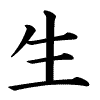 There are those that tout namazake (unpasteurized sake) as better, more special, more rare. That last term surely applies but, the truth is, that nama is not unequivocally better than its pasteurized counterpart. I am not saying nama is not good - perish the thought - it can be great. And if you like it, that’s all there is to it. There are those that tout namazake (unpasteurized sake) as better, more special, more rare. That last term surely applies but, the truth is, that nama is not unequivocally better than its pasteurized counterpart. I am not saying nama is not good - perish the thought - it can be great. And if you like it, that’s all there is to it.
Pasteurizing a sake; however, does not make it a lesser product. (Most of the time, it improves it, in my opinion.) If a brewer were to take half a batch and pasteurize it, and the other half and leave it nama, they become different from the moment the pasteurization occurs; and will mature differently, taking different paths from there on out. And never the twain shall meet. But neither is unequivocally better than the other.
Myth III: Color Sucks
While this seems to be more endemic within Japan rather than without, some consumers see color in sake – and I refer to that golden amber hue in freshly pressed sake that increases with age – as an indication of lesser quality. Poppycock!
Sake is born with that lovely amber tone to it and, sure, it can be filtered out. That, too, is fine; I am not against that. But leaving the color is a choice on the part of the brewer. It may be that the flavors are big and bouncy, and leaving a golden touch accents the richness. Or it may just be the brewer abhors using the powdered active charcoal used to strip that color away.
Of course, when sake gets just plain old, it takes on color too. While this can indicate it aging gracefully, it can mean it’s simply way past its prime. But the point here is that, in and of itself, color in sake does not suck.
Myth IV: Arabashiri is the Best of the Three
While this one is less of an issue and more technical in nature, there are many that think that “arabashiri” sake is the best of the pressing.
To review (and you can learn more here), good sake can be split into thirds (or so) when being pressed, i.e. separated from the lees. The 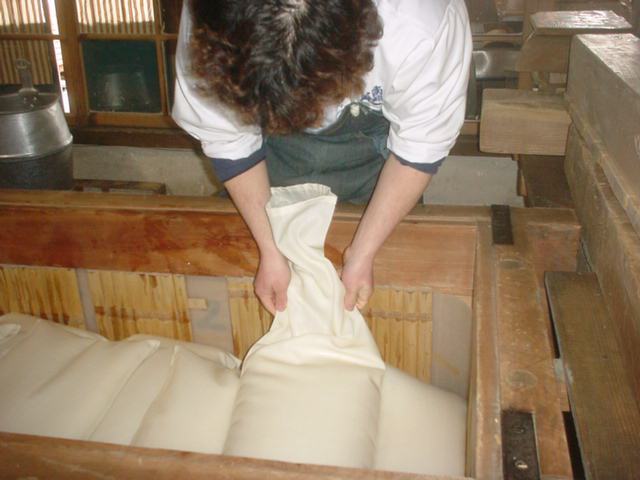 first third is rough-and-tumble, and a bit brash. This is called arabashiri, which translates directly into “rough run.” The middle part is called nakadare or nakagumi, and it is this portion that is generally regarded as the best of the lot. The final round of pressure yields a bit more sake, and this is called seme, and this is most often mixed into lesser stuff. first third is rough-and-tumble, and a bit brash. This is called arabashiri, which translates directly into “rough run.” The middle part is called nakadare or nakagumi, and it is this portion that is generally regarded as the best of the lot. The final round of pressure yields a bit more sake, and this is called seme, and this is most often mixed into lesser stuff.
A handful of breweries successfully market their arabashiri for the rough run that it is. That’s fine; it can be very, very good and particularly enjoyable for its brashness and, usually, youth. But in truth, at the end of the day, all marketing aside, it is the next one-third of the pressing, the aforementioned nakadare or nakagumi, that is the true prize.
So please, drink what you want, without bias or preconceived notions, be it junmai (or not), be it nama (or not), with color or without, and from whatever part of the pressing you find before you. Sake is indeed the stuff of myths, but the above four should not be counted amongst them.
|
Sake Professional Course
Although this has filled up faster than expected, there are still a few (currently, eight) seats open. Please contact me asap if interested.
San Francisco, CA, June 20, 21 and 22, 2010
On June 20, 21 and 22, 2010, I will hold the fifth stateside version of the Sake Professional Course the Bentley Reserve in San Francisco. The content of this three-day intensive sake course will be identical to that of the Sake Professional Course held each January in Japan, excepting; of course, sake brewery tours. The course is geared toward industry professionals wishing to expand their horizons in a thorough manner into the world of sake, and will; therefore necessarily, be fairly technical in nature and, admittedly, somewhat intense. But the course is open to anyone with an interest in sake, and it will certainly be fun!
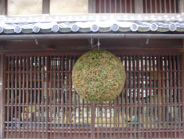 The course lectures and tastings will begin with the utter basics and will thoroughly progress through, and cover everything related, to sake. There will be an emphasis on empirical experience, with plenty of exposure to a wide range of sake in the tasting sessions throughout the three days. The course lectures and tastings will begin with the utter basics and will thoroughly progress through, and cover everything related, to sake. There will be an emphasis on empirical experience, with plenty of exposure to a wide range of sake in the tasting sessions throughout the three days.
The goal of this course is that "no sake stone remains left unturned." Every conceivable sake-related topic will b covered, and each lecture will be complimented and augmented by a relevant tasting. Like its counterpart held in Japan each winter, it will be quite simply the most thorough English-language sake education in existence. Participants will also be presented with a certificate of completion at the end of the course, and will also have the opportunity to take an exam for Level I Sake Specialist certification immediately following the course. The cost for the three-day class, including all materials and all sake for tasting, is US$775. Participation is limited, and reservations can be made now to secure a seat, with payment due by May 3, 2010. For a view of the syllabus, please seewww.sake-world.com/html/spclv.html. Testimonials from past participants are there too. For reservations or inquiries, please email SakeCourseStateside@sake-world.com.
Check out testimonials written by past participants here.
|
Did you know? 
All rice has more starch in the center, not just sake rice.
As readers surely recall, most premium sake is made from rice that is different from that which we find under fish in sushi, and in bowls otherwise. Those differences are size of stalk and grain, less fat and protein and more starch, and the physical construction wherein we find more of that starch in the center. This lets brewers remove the less desirable fat and protein near the outside by milling it away.
 But the truth is that all rice, not just sake rice, has more starch in the center and more fat and protein near the outside of the grain. It’s just that it’s so much more vivid and well separated in sake rice. But the truth is that all rice, not just sake rice, has more starch in the center and more fat and protein near the outside of the grain. It’s just that it’s so much more vivid and well separated in sake rice.
Why do I bother to bring this point up? Because I have many times heard the question asked, when someone sees a sake made with table rice, why would they mill the rice down very much, even ginjo levels, if it is only table rice? If the starches and fat and protein are all mixed up, what does it matter?
It does matter since, even in table rice, at least a little more of the starches are in the center, and at least a little more of the fat and protein are near the outside.
|
Sake basics
While there is surely limited usefulness to force-feeding Japanese terms to sake fans, to a certain degree it is necessary to learn a few, and to a more vague degree it is fun to learn ‘em. Certainly, you need things like ginjo and junmai to, at least, begin to understand sake and; thereby, enjoy it more. But the law of diminishing returns kicks in with a mighty vengeance soon after that, as most sake drinkers lack linguistic aspiration - which is fine.
Still, should your fondness for sake ever take you to a brewery, at least in Japan, a handful of other terms will serve you very well. Here are a few etymologically related.
Kura 
A “kura” is a brewery. (Note, there is a homonym that means storehouse, but the character is different.) Very commonly, to make things clear if more context is needed, the word “sakagura” is used. (The final e in sake becomes an a when in this combination.) So kura and sakagura both refer to a sake brewery.
Kurabito
A “kurabito” is a brewery worker, one who makes sake. The 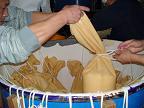 second half of that word, “bito,” is really “hito,” meaning person. So kurabito means “a person of the brewery,” i.e. a member of the brewing staff. Strictly speaking; however, the master brewer, called the “toji,” is not referred to as a kurabito. Basically. Sorta. It’s kinda vague, surprise surprise. But, in the end, brewing personnel are called kurabito. second half of that word, “bito,” is really “hito,” meaning person. So kurabito means “a person of the brewery,” i.e. a member of the brewing staff. Strictly speaking; however, the master brewer, called the “toji,” is not referred to as a kurabito. Basically. Sorta. It’s kinda vague, surprise surprise. But, in the end, brewing personnel are called kurabito.
Kuramoto
The “kuramoto” is the brewery owner, or perhaps the owning family, depending on the reference. Note - only a couple (perhaps five?) kura in Japan are corporations; the rest are family owned and handed down from generation to generation. (The longest running of these is Sato no Homare, currently in its 55th generation!). Perhaps it is easiest to think of the kuramoto as the current president of the company.
So, next time you are in Japan, if you are fortunate enough to have the kuramoto lead you through his kura, and you see a kurabito darting about, you will feel totally on top of things.
|
Japanese For Sake Lovers
A Guide to Proper Pronunciation
Here it is: something that ensures you will enjoy your sake experience more and more - a short, concise instructional guide on how to properly and naturally pronounce the Japanese language, sake brand names, and all the terminology that is a part of the sake world. With the help of this little course, you will sound like a native when talking about sake.
No more butchering sake names in Japanese! Learn how to properly pronounce the sake you love!
Japanese for Sake Lovers consists of a short text and three audio files. It all begins with a guide to the theory of pronouncing Japanese, which you will soon realize is surprisingly simple. Following that, you will have the opportunity to practice pronunciation of all the important terminology surrounding sake, and dozens of brand names that cement in your mind the principles, fundamentals, and idiosyncrasies of pronouncing Japanese.
This is not a language text. You will not learn grammar or much 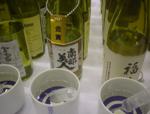 vocabulary outside of sake-specific terms; although, it does include a handful of phrases to help you navigate your way to sake bliss in Japanese when at a sake pub. It is augmented by three audio files that allow you to practice, repeating the words and phrases after a native speaker. vocabulary outside of sake-specific terms; although, it does include a handful of phrases to help you navigate your way to sake bliss in Japanese when at a sake pub. It is augmented by three audio files that allow you to practice, repeating the words and phrases after a native speaker.
Until May 31, Japanese for Sake Lovers is being offered at an introductory price of $9.99, after which the price will be raised a smidgeon. Go here now to order your copy, and feel one step closer to the beverage you love – guaranteed.
|
Odds-n-Ends 
The archives of this newsletter are again up-to-date. If you have missed any, feel free to check them out on the Sake-World site.
More information on the following topics can be found here.
Sake Homebrewing
Books on Sake
Information on the archives of this newsletter
General information related to this publication
|

Are you not getting this newsletter? I realize that is like asking that "those not present please raise your hand," but for future reference, should you spontaneously stop receiving this newsletter, please go here and sign up again. Should that not work, please go to www.sake-world.com.
Email newsletter services are very careful not to be considered spam enablers, but the problem is that often very valid email addresses come back bounced as invalid. It is an unavoidable problem. So if you or someone you know is not getting this, or stop(s) receiving it inexplicably, please do take a moment to double check that you are still subscribed.
Sincere apologies for the hassle, mixed with gratitude for reading this newsletter.
|
I hope you have found the above information helpful and entertaining. For more information about all things sake, please check out www.sake-world.com. Until next month, warm regards, and enjoy your sake. 
Questions and comments should be directed to John Gauntner, at this email address.
*Satisfaction Guaranteed*
Should Japanese For Sake Lovers not significantly improve your ability to pronounce all sake-related terms and words, your money will be cheerfully refunded, no questions asked.
All material Copyright, John Gauntner & Sake World Inc.
Regards,
John Gauntner
Sake World, Inc.
|
|
